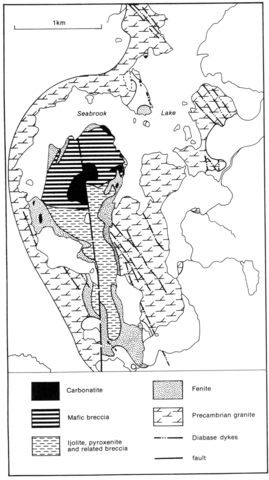stripes
An elongated carbonatite-ijolite complex of 2.7x1 km, extending along and cut by a north-south-trending fault, is emplaced in massive Precambrian granites and diabase dykes. Outcrop is abundant and drilling extensive so that the complex is reasonably well defined. The principal rocks are ijolites, biotite pyroxenites and melteigites. Foliation and a vague layering is sometimes apparent and there are sharp contacts between rock types. Nepheline forms cross-cutting stringers. Mitchell (1972) gives analyses of nepheline, salitic pyroxene with aegirine-augite rims, and Ba and F-rich biotites from these rocks. The northern part of the intrusion consists of heterogeneous mafic breccias of widely varying proportions of carbonate, biotite, pyroxene, secondary minerals, and accessory magnetite, sulphides and fluorite; feldspar and nepheline are absent. The rocks are fragmental, cut by numerous foliated carbonatite dykes, and grade inwards from marginal carbonated granite breccias. The carbonatites are strongly foliated rocks forming a central mass and dykes within the breccias as well as dykes cutting the country rock granites. They are calcitic and dolomitic with pyroxene, amphibole, magnetite, pyrochlore and chlorite. The granites and diabase dykes are brecciated and fenitized adjacent to the complex with the production of sodic pyroxenes and amphiboles, and in some areas carbonate. A detailed study of the REE in Seabrook Lake has been made by Cullers and Medaris (1977), and data on oxygen isotopes are available in Deines and Gold (1973, p. 1720).
CULLERS, R.L. and MEDARIS, G. 1977. Rare earth elements in carbonatite and cogenetic alkaline rocks: examples from Seabrook Lake and Callander Bay,
DEINES, P. and GOLD, D.P. 1973. The isotopic composition of carbonatite and kimberlite carbonates and their bearing on the isotopic composition of deep-seated carbon. Geochimica et Cosmochimica Acta, 37: 1709-33.
GITTINS, J., MACINTYRE, R.M. and YORK, D. 1967. The ages of carbonatite complexes in eastern Canada. Canadian Journal of Earth Sciences, 4: 651-5.
MITCHELL, R.H. 1972. Composition of nepheline, pyroxene and biotite in ijolite from the Seabrook Lake complex, Ontario, Canada. Neues Jahrbuch fur Mineralogie, Stuttgart, Monatshefte, 9: 415-22.
PARSONS, G.E. 1961. Niobium-bearing complexes east of Lake Superior. Geological Report, Ontario Department of Mines, 3: 1-73.

